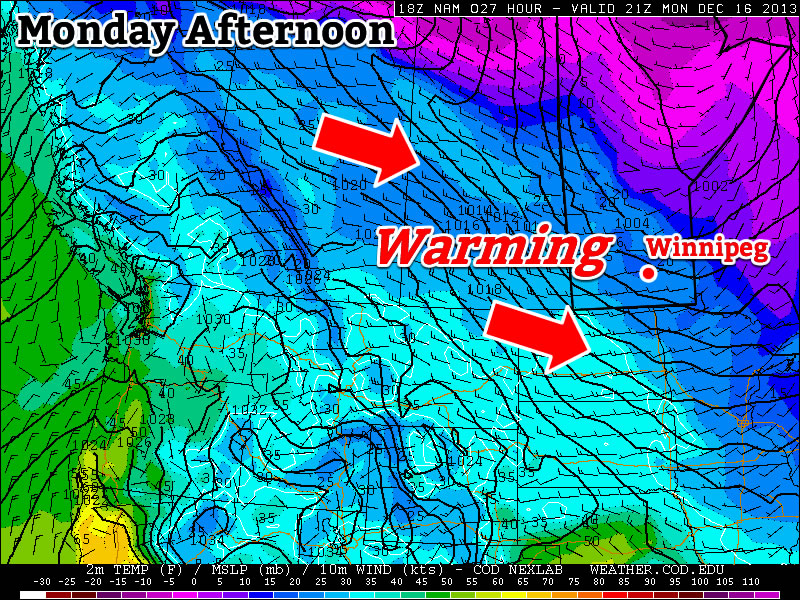After enjoying a well above-normal –2°C daytime high on Monday, things are set to plunge back into the deep freeze as an Alberta Clipper low pressure system tracks into Ontario and allows a new supply of very cold Arctic air to surge southwards across the Prairies.
The Clipper
-9°C / -26°C
Mostly cloudy; flurries likely. Windy.
A potent Alberta Clipper will move through Manitoba today with the bulk of it’s snow falling along a line from Flin Flon through Norway House and Beren’s River where anywhere from 4–10cm can be expected. Further south, we’ll see light snow through the Parkland and Interlake through much of the day, but the snow won’t start in earnest until the afternoon along and south of the Trans-Canada Highway when the cold front associated with this system moves through.
And what a cold front it is! Yesterday saw genuine flash-freezes in the high plains of the Rockies; Dawson Creek, BC had it’s temperature fall from +5°C to –16°C in just 3 hours. In Grand Prairie, AB temperatures plummeted similarly, with temperatures falling from +5°C to –15°C in just 3 hours as well. It’s this intense blast of arctic air which will help this system produce snow despite the fact it is lacking considerable moisture.
While temperatures won’t be set to plummet quite so dramatically further east in Manitoba, we’ll certainly see the cold air return with a blast. We’ll be dealing with snow, wind, blowing snow and bitterly cold temperatures/wind chill by the end of the day today. Here’s what you can expect:
Snow: We’ll likely see scattered light flurries through the morning and early afternoon. Marginally more organized snow will try to push in through the afternoon along the cold front, but the system will have difficulty producing much snowfall anywhere other than along the northern edge of the track of the low pressure system. By the time things taper off this evening, anywhere from just a trace of snow to 2–3cm will likely have fallen in Winnipeg & the Red River Valley.
Wind & Blowing Snow: Winds will remain fairly light through the day until the passage of the cold front early this afternoon. Behind the front the winds will flip to the northwest and pick up strength to 30–40km/h with gusts as high as 60km/h. This wind will couple with the loose snow on the ground and the falling snow to produce widespread blowing snow through much of the Red River Valley. The worst areas for blowing snow will be the western and central RRV on any west-east running roads, including the Trans-Canada Highway between Winnipeg & Portage la Prairie. If you have plans to travel west on the Trans-Canada Highway today, be prepared for slippery roads with snow and blowing snow producing very poor visibilities.
Falling Temperatures/Wind Chill: Temperatures will fall quite aggressively behind the cold front with temperatures dropping from our daytime high of around –9°C to an overnight low of around –26°C. The cold temperatures coupled with the wind will produce wind chill values near –35 through the overnight hours.
The Remainder of the Week
-21°C / -28°C
Sunny & cold.
The remainder of the week through the beginning of next week will be marked by the presence of yet another significant Arctic air mass entrenched over the Prairies. We’ll see mainly sunny skies on Thursday with light winds but temperatures will be very cold. Our high will only climb to around –22 or –21°C before plummeting back down to –28 or –29°C for our overnight low on Thursday night.
-17°C / -25°C
Some afternoon cloud.
Temperatures will climb a little higher on Friday as a very weak disturbance ripples down the northwest flow, spilling a little bit of cloud across Southern Manitoba by the afternoon hours. The temperature will climb up to around –17°C and we’ll see the temperature drop to around –25°C on Friday night.
Things look clear and cold for the weekend. Another shot of Arctic air will push into the Red River Valley bringing another batch of bitterly cold temperatures and overnight lows near –30°C.




.png)

